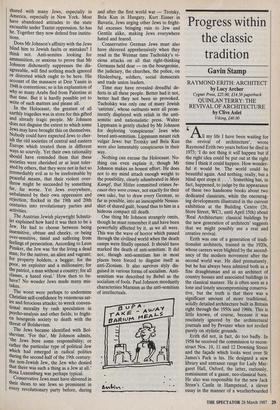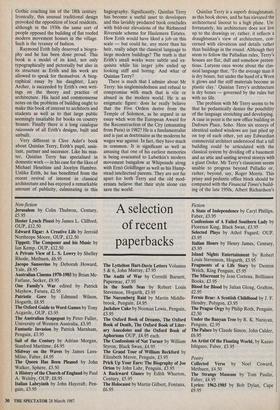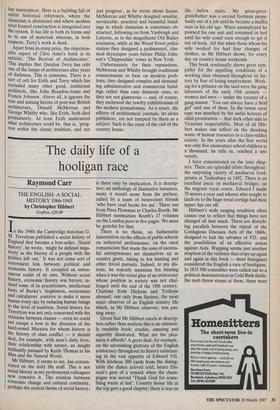Progress within the classic tradition
Gavin Stamp
RAYMOND ERITH: ARCHITECT by Lucy Archer
Cygnet Press, £25.00, £14.50 paperback
QUINLAN TERRY: THE REVIVAL OF ARCHITECTURE by Clive Aslet
Viking, £40.00
All my life I have been waiting for the revival of architecture', wrote Raymond Erith two years before he died in 1973; `I do not thing it will happen but if the right idea could be put out at the right time I think it could happen. How wonder- ful it would be. The world could be beautiful again. And nothing, really, but a blind spot stops it . . .'. Something has, in fact, happened, to judge by the appearance of these two handsome books about two dedicated classicists, while the encourag- ing developments illustrated in the current exhibition at the Building Centre (26, Store Street, WC1, until April 15th) about 'Real Architecture: classical buildings by the new generation of architects' suggests that we might possibly see a real and creative revival.
Erith was one of a generation of tradi- tionalist architects, trained in the 1920s, whose careers were blighted by the ascend- ancy of the modern movement after the second world war. He died prematurely, but he has always been admired both as a fine draughtsman and as an architect of country houses and associated buildings in the classical manner. He is often seen as a lone and lonely uncompromising conserva- tive, but the truth is that there was a significant amount of more traditional, solidly detailed architecture built in Britain right through the 1950s and 1960s. This is little known, of course, because it was resolutely ignored by the architectural journals and by Pevsner when not reviled purely on stylistic grounds.
Erith did not, in fact, do too badly. In 1958 he received the commission to recon- struct Nos. 10, 11 and 12 Downing Street and the façade which looks west over St James's Park is his. He designed a new library and entrance range for Lady Mar- garet Hall, Oxford, the latter, curiously, reminiscent of a gaunt, neo-classical barn. He also was responsible for the new Jack Straw's Castle in Hampstead, a clever essay in the manner of a weatherboarded Gothic coaching inn of the 18th century. Ironically, this unusual traditional design provoked the opposition of local residents, although in the 1930s the same sort of people opposed the building of flat roofed modern movement houses in the village. Such is the tyranny of fashion.
Raymond Erith fully deserved a biogra- phy and he has been done proud. This book is a model of its kind, not only typographically and pictorially but also in its structure as Erith and his work are allowed to speak for themselves. A biog- raphical essay by his daughter, Lucy Archer, is succeeded by Erith's own writ- ings on the theory and practice of architecture. His lucid and commonsense notes on the problems of building ought to make this book of interest to architects and students as well as to that large public seemingly insatiable for books on country houses. Finally there is a long catalogue raisonnee of all Erith's designs, built and unbuilt.
Very different is Clive Aslet's book about Quinlan Terry, Erith's pupil, assis- tant, partner and successor. Like his mas- ter, Quinlan Terry has specialised in domestic work - in his case for the likes of Michael Heseltine and Jocelyn Hambro. Unlike Erith, he has benefitted from the recent revival of interest in classical architecture and has enjoyed a remarkable amount of publicity, culminating in this hagiography. Significantly, Quinlan Terry has become a useful asset to developers and this lavishly produced book concludes with fold-out elevations of the Richmond Riverside scheme for Haslemere Estates. How Erith would have liked a job on this scale - but could he, any more than his heir, really adapt the classical language to large modern buildings? The truth is that Erith's small works were subtle and ex- quisite while his larger jobs ended up looking stiff and boring. And what of Quinlan Terry?
There is much that I admire about Mr Terry: his singlemindedness and refusal to compromise with much that is vile or absurd in the modern world. He is an enigmatic figure: does he really believe that the Five Orders derive from the Temple of Solomon, as he argued in an essay whch won the European Award for the Reconstruction of the City (emanating from Paris) in 1982? He is a fundamentalist and is just as doctrinaire as the moderns he wages war against. In fact, they have much in common. It is significant as well as amusing that one of his earliest memories is being evacuated to Lubetkin's modern movement bungalow at Whipsnade aloqg with Erno Goldfinger as well as his Hamp- stead intellectual parents. They are not far apart for both Terry and the old mod- ernists believe that their style alone can save the world. Quinlan Terry is a superb draughtsman, as this book shows, and he has elevated the architectural linocut to a high plane. Un- fortunately, his architecture does not live up to the drawings or, rather, it reflects a draughtsman's view of architecture, con- cerned with elevations and details rather than buildings in the round. Although they seem to follow the Palladian rules, Terry's houses are flat, dull and somehow preten- tious. Lutyens once wrote about the clas- sical language that, 'To the average man it is dry bones, but under the hand of a Wren it glows and the stiff materials become as plastic clay.' Quinlan Terry's architecture is dry bones - governed by the rules but with no life.
The problem with Mr Terry seems to be that he pedantically denies the possibility of the language stretching and developing. A case in point is the new office building in Dufours Place, Soho. Here six storeys of identical sashed windows are just piled up on top of each other, yet any Edwardian commercial architect understood that a tall building could be articulated with the classical system by dividing off a basement and an attic and uniting several storeys with a giant Order. Mr Terry's classicism seems unable to progress beyond Palladio or, rather, beyond, say, Roger Morris. This prissy and pedantic office block should be compared with the Financial Times's build- ing of the late 1950s, Albert Richardson's last masterpiece. Here is a building full of subtle historical references, where the classicism is abstracted and where modern steel framed construction is integrated into the system. It has life in both its forms and in its use of materials whereas, in both respects, Terry's work is dead.
Apart from its steep price, the objection- able aspect of Clive Aslet's book is its subtitle: 'The Revival of Architecture'. This implies that Quinlan Terry has relit one of the lamps of architecture after years of darkness. This is nonsense. There is a sort of cult for Erith and Terry which has excluded many other good, traditional architects, like John Brandon-Jones and Francis Johnson. Above all, it ignores the true and unsung heroes of post-war British architecture, Donald McMorran and George Whitby who, like Erith, both died Prematurely. At least Erith understood What architecture could be, that is, 'prog- ress within the classic tradition, and not just progress', as he wrote about Soane. McMorran and Whitby designed sensible, serviceable, practical and beautiful build- ings in which classicism is sometimes ab- stracted, following on from Vanbrugh and Lutyens, as in the magnificent Old Bailey extension, while at the Wood Street police station they designed a pedimented, clas- sical skyscraper years before Philip John- son's 'Chippendale' tower in New York.
Unfortunately for their reputations, McMorran and Whitby brought traditional commonsense to bear on modern prob- lems; they designed complex and demand- ing administrative and commercial build- ings rather than easy domestic ones, so they are not glamorous — and, of course, they eschewed the tawdry exhibitionism of the modern primadonnas. As a result, the editors of architectural journals, let alone publishers, are not tempted by them as a subject. Such is the curse of the cult of the country house.




















































 Previous page
Previous page